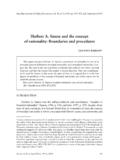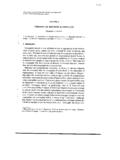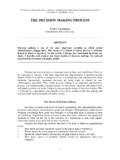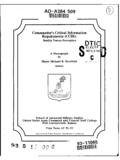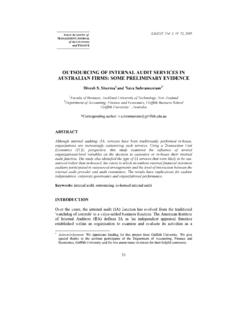Transcription of Reasoning the Fast and Frugal Way: Models of Bounded ...
1 Psychological Review Copyright 1996 by the American Psychological Association, Inc. 1996, Vol. 103. No. 4, 650-669 0033-295X/96/$ Reasoning the fast and Frugal Way: Models of Bounded Rationality Gerd Gigerenzer and Daniel G. Goldstein Max Planck Institute for Psychological Research and University of Chicago Humans and animals make inferences about the world under limited time and knowledge. In con- trast, many Models of rational inference treat the mind as a Laplacean Demon, equipped with un- limited time, knowledge, and computational might. Following H. Simon's notion of satisficing, the authors have proposed a family of algorithms based on a simple psychological mechanism: one- reason decision making. These fast and Frugal algorithms violate fundamental tenets of classical rationality: They neither look up nor integrate all information.
2 By computer simulation, the authors held a competition between the satisficing "Take The Best" algorithm and various "rational" infer- ence procedures ( , multiple regression). The Take The Best algorithm matched or outperformed all competitors in inferential speed and accuracy. This result is an existence proof that cognitive mechanisms capable of successful performance in the real world do not need to satisfy the classical norms of rational inference. Organisms make inductive inferences. Darwin ( 1872/1965 ) observed that people use facial cues, such as eyes that waver and lids that hang low, to infer a person's guilt. Male toads, roaming through swamps at night, use the pitch of a rival's croak to infer its size when deciding whether to fight (Krebs & Davies, 1987). Stock brokers must make fast decisions about which of several stocks to trade or invest when only limited information is avail- able.
3 The list goes on. Inductive inferences are typically based on uncertain cues: The eyes can deceive, and so can a tiny toad with a deep croak in the darkness. How does an organism make inferences about unknown as- pects of the environment? There are three directions in which to look for an answer. From Pierre Laplace to George Boole to Jean Piaget, many scholars have defended the now classical view that the laws of human inference are the laws of probability and statistics (and to a lesser degree logic, which does not deal as easily with uncertainty). Indeed, the Enlightenment probabi- lists derived the laws of probability from what they believed to be the laws of human Reasoning (Daston, 1988). Following this time-honored tradition, much contemporary research in psy- chology, behavioral ecology, and economics assumes standard Gerd Gigerenzer and Daniel G.
4 Goldstein, Center for Adaptive Be- havior and Cognition, Max Planck Institute for Psychological Research, Munich, Germany, and Department of Psychology, University of Chicago. This research was funded by National Science Foundation Grant SBR-9320797/GG. We are deeply grateful to the many people who have contributed to this article, including Hal Arkes, Leda Cosmides, Jean Czerlinski, Lor- raine Daston, Ken Hammond, Reid Hastie, Wolfgang Hell, Ralph Her- twig, Ulrich Hoffrage, Albert Madansky, Laura Martignon, Geoffrey Miller, Silvia Papal, John Payne, Terry Regier, Werner Schub6, Peter Sedlmeier, Herbert Simon, Stephen Stigler, Gerhard Strube, Zeno Swi- jtink, John Tooby, William Wimsatt, and Werner Wittmann. Correspondence concerning this article should be addressed to Gerd Gigerenzer or Daniel G.
5 Goldstein, Center for Adaptive Behavior and Cognition, Max Planck Institute for Psychological Research, Leo- poldstrasse 24, 80802 Munich, Germany. Electronic mail may be sent via Internet to statistical tools to be the normative and descriptive Models of inference and decision making. Multiple regression, for in- stance, is both the economist's universal tool (McCloskey, 1985 ) and a model of inductive inference in multiple-cue learn- ing (Hammond, 1990) and clinical judgment (B. Brehmer, 1994); Bayes's theorem is a model of how animals infer the presence of predators or prey (Stephens & Krebs, 1986) as well as of human Reasoning and memory (Anderson, 1990). This Enlightenment view that probability theory and human reason- ing are two sides of the same coin crumbled in the early nine- teenth century but has remained strong in psychology and economics.
6 In the past 25 years, this stronghold came under attack by proponents of the heuristics and biases program, who con- cluded that human inference is systematically biased and error prone, suggesting that the laws of inference are quick-and-dirty heuristics and not the laws of probability (Kahneman, Slovic, & Tversky, 1982). This second perspective appears diametrically opposed to the classical rationality of the Enlightenment, but this appearance is misleading. It has retained the normative kernel of the classical view. For example, a discrepancy between the dictates of classical rationality and actual Reasoning is what defines a Reasoning error in this program. Both views accept the laws of probability and statistics as normative, but they disagree about whether humans can stand up to these norms.
7 Many experiments have been conducted to test the validity of these two views, identifying a host of conditions under which the human mind appears more rational or irrational. But most of this work has dealt with simple situations, such as Bayesian inference with binary hypotheses, one single piece of binary data, and all the necessary information conveniently laid out for the participant (Gigerenzer & Hoffrage, 1995). In many real-world situations, however, there are multiple pieces of in- formation, which are not independent, but redundant. Here, Bayes's theorem and other "rational" algorithms quickly be- come mathematically complex and computationally intracta- ble, at least for ordinary human minds. These situations make neither of the two views look promising. If one would apply the classical view to such complex real-world environments, this 650 Reasoning THE fast AND Frugal WAY 651 would suggest that the mind is a supercalculator like a Lapla- cean Demon (Wimsatt, 1976 )---carrying around the collected works of Kolmogoroff, Fisher, or Neyman--and simply needs a memory jog, like the slave in Plato's Meno.
8 On the other hand, the heuristics-and-biases view of human irrationality would lead us to believe that humans are hopelessly lost in the face of real-world complexity, given their supposed inability to reason according to the canon of classical rationality, even in simple laboratory experiments. There is a third way to look at inference, focusing on the psy- chological and ecological rather than on logic and probability theory. This view questions classical rationality as a universal norm and thereby questions the very definition of "good" rea- soning on which both the Enlightenment and the heuristics- and-biases views were built. Herbert Simon, possibly the best- known proponent of this third view, proposed looking for Models of Bounded rationality instead of classical rationality.
9 Simon (1956, 1982) argued that information-processing sys- tems typically need to satisfice rather than optimize. Satisficing, a blend of sufficing and satisfying, is a word of Scottish origin, which Simon uses to characterize algorithms that successfully deal with conditions of limited time, knowledge, or computa- tional capacities. His concept of satisficing postulates, for in- stance, that an organism would choose the first object (a mate, perhaps) that satisfies its aspiration level--instead of the intrac- table sequence of taking the time to survey all possible alterna- tives, estimating probabilities and utilities for the possible out- comes associated with each alternative, calculating expected utilities, and choosing the alternative that scores highest. Let us stress that Simon's notion of Bounded rationality has two sides, one cognitive and one ecological.
10 As early as in Ad- ministrative Behavior ( 1945 ), he emphasized the cognitive lim- itations of real minds as opposed to the omniscient Laplacean Demons of classical rationality. As early as in his Psychological Review article titled "Rational Choice and the Structure of the Environment" (1956), Simon emphasized that minds are adapted to real-world environments. The two go in tandem: "Human rational behavior is shaped by a scissors whose two blades are the structure of task environments and the computa- tional capabilities of the actor" (Simon, 1990, p. 7). For the most part, however, theories of human inference have focused exclusively on the cognitive side, equating the notion of Bounded rationality with the statement that humans are limited information processors, period.


